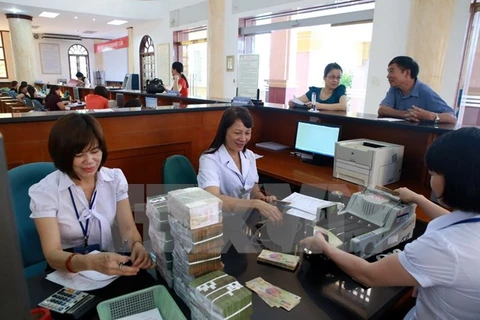Hanoi (VNS/VNA) - State budget revenues falling short of the half-way mark in the first six months of the year is a normal feature of the domestic economy and does not preclude meeting the annual target, Finance Minister Dinh Tien Dung tells Vietnam News.
Q: In the first half this year, the total State budget collection met just 46.5 percent of the annual target. How do you assess this result? Does this make the target set by the National Assembly (NA) for 2017 difficult to reach?
A: This has to be put in perspective. Budget revenues for the first six
months present an increase of nearly 13 percent over the same period in 2016, even though it fulfills only 46.5 percent of the annual target.
Domestic collection rose 12.4 percent year-on-year, or 45.5 percent of the annual plan. If we take out land use taxes, income from lottery sales, revenues from selling the State’s stake in enterprises, dividend revenues and profits after tax, domestic revenues rose by more than 10.5 percent, which is basically in line with the economic growth rate of 5.73 percent as well as the inflation rate of 4.15 percent in the first six months.
A majority of the localities, 54 of 63, have done well in budget collection, including Hanoi, HCM City, Quang Ninh, Hai Phong and Quang Ngai.
We should also keep in mind that budget revenues in the first six months of the year usually falls short of 50 percent of the annual target as localities focus on boosting production in the last months of the year, which is a distinctive feature of our economy. Therefore, with the budget revenue results achieved in H1, we believe that the finance sector will fulfill and even exceed budget collection goals set by the National Assembly, which are expected to rise year-on-year by five to eight percent.
However, it cannot be denied that the economy still faces many tricky challenges, especially hardships in production and business. Therefore, from now until the end of the year, the financial sector will have to work hard and adopt drastic measures to ensure security and sustainability.
Q: It has been seen in recent years that local budget collection surpasses targets while the central budget collection fails to meet them. Will this situation be repeated this year?
A: At the second session of the National Assembly, we reported that central budget revenue would fall short of the target by 8-12 trillion VND last year, but in the end, the shortfall was just 321 billion VND.
Local budget revenue was expected to surpass the target by 36 trillion VND, but it went up by 82 trillion VND, eventually.
In the first half of this year, while central budget revenue met 41.5 percent of the annual plan, local revenues trumped it by four percent.
The financial sector will take this into account, make careful calculations and take drastic measures to ensure a balanced State budget.
Q: Could you elaborate on some of the measures?
A: The sector has actively carried out several solutions in tandem to prevent losses and avert a budget deficit, including increasing inspections, strengthening supervision and auditing to prevent tax evasion, reduce tax arrears and detect and prevent transfer pricing. In 2016, tax authorities inspected over 84,500 enterprises, reducing State Budget losses by nearly 17.2 trillion VND and recovering 42.5 trillion VND in arrears, an increase of nearly 39 percent and 13.2 percent over 2015. This, in turn, reduced tax arrears at the end of 2016 to 74.1 trillion VND, down 3 percent over 2015.
Q: Apart from strengthening inspections, auditing, etc., what are other measures that the sector envisages as it tries to ensure a balanced State budget in the long term?
Firstly, the finance sector will continue to perfect the financial and budgetary system to progressively restructure the State budget and keep public debt under control.
Specifically, in the second half of 2017 and early 2018, the Ministry of Finance will submit to the Government and the National Assembly changes in the environmental protection tax; amendments and supplements to some provisions of the laws on corporate tax, individual tax, value-added tax, national-resource tax and tax management. These changes are very important for restructuring the State budget in the context of low global oil prices and deeper international integration, which has resulted in reduced tariffs and lower revenues from import-export activities.
Secondly, we will continue our fiscal tightening policy, exercise thrift and review State budget expenditures to reduce overspending. We will also accelerate reform of the nation’s financial system towards greater efficiency, and allocate more funds for infrastructure development.
Thirdly, we will reform the financial management system in the areas of taxation, customs, treasury, including the application of information technology.
Fourthly, we will continue to find solutions to reduce costs for businesses. In particular, we will review documents relating to business tax contributions, social insurance, health insurance, unemployment insurance and all other expenses that they are responsible for. This will help reduce corporate spending and create favourable conditions for businesses to develop, promote production and business, which is a long-term strategy for ensuring stable, sustainable revenue sources for the State budget.
Q: What are some of the specific objectives that the finance sector has set for the future?
A: The sector will strive to successfully complete some specific objectives by 2020. Average state budget mobilisation for the 2016-2020 period is estimated at about 20-21 percent of GDP, and total budget revenue for the period is forecast at 1.65 times that of the 2011-2015 period.
Domestic collection is expected to account for 84-85 percent of State budget income, with 14-16 percent coming from crude oil export and other import-export activities.
Meanwhile, central budget revenues are set to reach 60-65 percent of total budget collection. The sector will also reduce State budget overspending, not exceeding 3.5 percent of GDP by 2020.
At the same time, public debt for the 2016-2020 period will be reined in at a maximum of 65 percent of the GDP, while Government debt and national foreign debt will not exceed 55 percent and 50 percent of GDP respectively.-VNA
VNA
























